The flow objects are divided into the following three groups:
- Activities
- Gateways
- Events
Activities
Belong to the group of activities:
- Tasks
- Transactions
- Event Subprocess
- Call Activity
Task
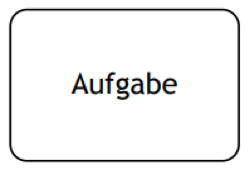
A task is an elementary unit of work.
An additional [+] marks an activity as a closed subprocess.
Annotation:
Most BPMN modeling tools allow a subprocess to be expanded or collapsed by clicking on the [+] symbol. As a result, any detailing of the representation (zooming) can be achieved, as a result of which the readability and comprehensibility of the diagrams is substantially improved.
Example:
Transaction
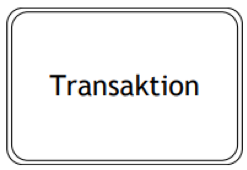
A transaction is a group of activities that logically belong together.
The transaction log can also be specified.
Event Subprocess
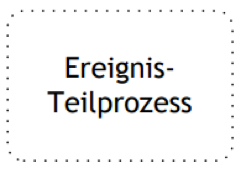
An event subprocess is placed in another sub-process. It is triggered by a start event and can interrupt the surrounding sub-process – depending on the type of start event – or interrupt it in parallel.
Call Activity
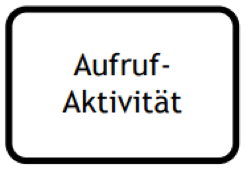
A Call Activity represents either another process or a globally defined task that is used (called) in the current process.
Gateways
Through the use of gateways, two goals are achieved in process sequences:
- Branching of a process execution into alternative (split) or multiple (fork) execution paths, or
- Merging of multiple alternative (merge) or concurrent (join) execution paths
Gateways can occur in different forms:
- Default or Exclusive (XOR) Gateway
- Parallel (AND) Gateway
- Inclusive (OR) Gateway
- Event-based Gateway
- Complex Gateway
The different types of gateways differ in branch and merge behavior!
Exclusive (XOR) Gateway
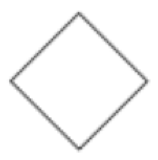
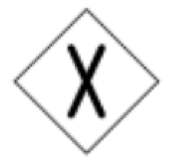 Branching: The flow is directed to exactly one outgoing edge, depending on conditions.
Branching: The flow is directed to exactly one outgoing edge, depending on conditions.
Merging: It waits for (any)one of the incoming edges to activate the outgoing flow.
Parallel (AND) Gateway
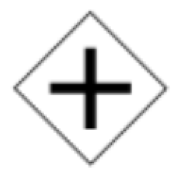 Branching: All outgoing edges are activated simultaneously.
Branching: All outgoing edges are activated simultaneously.
Merging: It waits for all incoming edges before the outgoing flow is activated (synchronization).
Inclusive (OR) Gateway
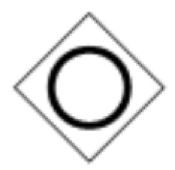 Depending on the condition, this gateway activates one or more outgoing edges or synchronizes incoming edges.
Depending on the condition, this gateway activates one or more outgoing edges or synchronizes incoming edges.
The logic of behavior is attached in the form of an annotation.
Event-based Gateway
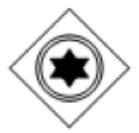 This gateway is followed by events or recipient tasks.
This gateway is followed by events or recipient tasks.
The sequence flow is directed to the event that occurs first.
Exclusive (XOR) event-based Gateway
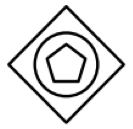 The process is started or continued if one of the following events occurs.
The process is started or continued if one of the following events occurs.
Parallel (AND) event-based Gateway
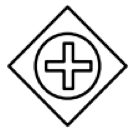 The process is started or continued when all of the subsequent events occur.
The process is started or continued when all of the subsequent events occur.
Complex Gateway
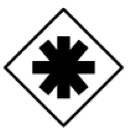 This gateway is for branch and merge scenarios that are not covered by the other gateways.
This gateway is for branch and merge scenarios that are not covered by the other gateways.
The logic of behavior is attached in the form of an annotation.
Events
Occurring events are distinguished as follows …
- the position in the process: Start, Intermediate, End
- the effect: Catching („white symbol“), Throwing („black symbol“)
- the kind: Message, Timer, Exception, …
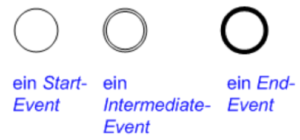
The first group (position in the process) is differentiated according to the type of surrounding circle.
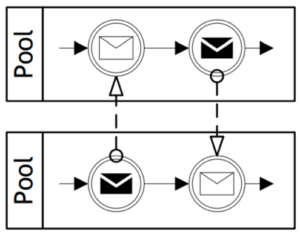
The second group (effect) according to the color of the symbol inside the circle:
A white icon (catching) indicates that an event is being received,
a black symbol (throwing) indicates that an event is triggered.
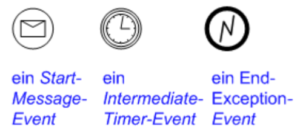
The symbol inside the circle indicates the third distinction criterion (type).
Combining these characteristics results in several concrete event types.
Posts (Activities):
- BPMN with EA: Task Activities
- BPMN with EA: Call Activities
- BPMN with EA: An Example
- BPMN with EA: Subprocess Activities
Posts (Gateways):
Posts (Events):
- BPMN with EA: An Example
- BPMN with EA: End Events
- BPMN with EA: Start Events
- BPMN with EA: Intermediate Events
Additional Information: Participants • Connecting Objects • Artifacts
Take advantage of our training offer or
design your individual training at a place of your choice.



